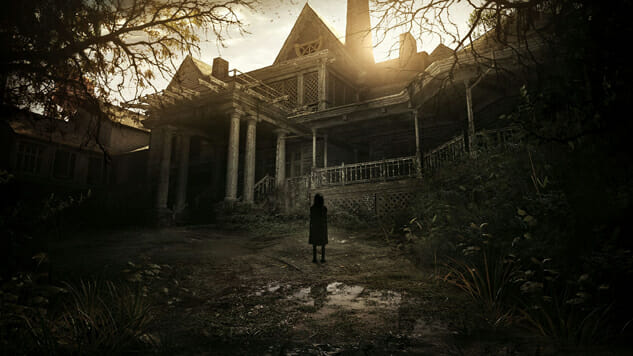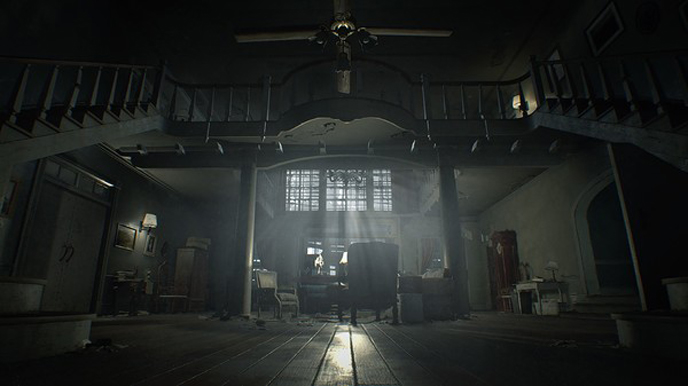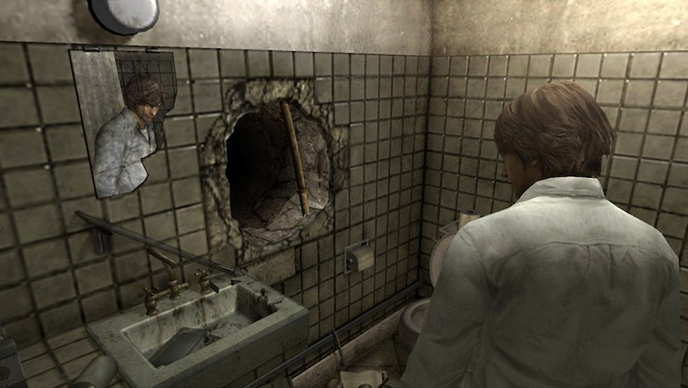On Intimate Encounters and Degradation of Sanctuary in Resident Evil 7
Games Features Resident Evil 7
Today, Resident Evil 7 will be released. This latest installation in the series is an intriguing return to its origins: a terrifying corruption of our own homes. It’s time to stop traveling the world to slay unholy abominations that threaten to destroy the world and remind ourselves why the word Resident is in the title.
As if to address the trepidation of the Resident Evil community about the new direction the series is taking, Capcom has deviated from the traditional press cycle to keep player expectations at bay. Fans are understandably hesitant about some of the new features announced with the sequel, including the switch from third to first person, and the game’s newfound emphasis on VR. Thus, following the game’s surprise announcement at E3 2016, a demo was made immediately available, and the game’s release date revealed as only seven months away, drastically reducing the potential build-up time for backlash. This was followed by a long period of silence punctuated only by demo updates and a few teaser trailers, which mostly served to assure series regulars that the familiar staples of the past would remain intact. Capcom has managed this makeover in an intriguing, if meticulous, way.
Resident Evil 7 doesn’t play like its immediate successors in the series, due to both this switch in perspective and Capcom’s renewed interest in smaller scale, intimate encounters. While the original Resident Evil was set in a mansion (and most of us can barely afford a studio apartment, much less a house) it still honed in on the idea that bad things can happen in our own homes. Later sequels became a ridiculous, globe-encompassing nightmare that, in expanding the once-intimate setting, lost both its meaning and its ability to evoke terror. On the surface, unsettling imagery like fleshy, writhing masses of tentacles and bone blades may seem scary, but without a grounded location, it simply crosses the line into the unbelievably bizarre.
The Paranormal Activity movies, love ‘em or hate ‘em, were predicated on this same type of horror. While rife with jump scares set in a dread-instilling atmosphere, the most powerful trick in the series’ bag was its ability to take you by surprise, lurking beneath your bed to drag you by the ankles at any moment. The haunting of a family or romantic couple becomes relatable because hey, I have a home too. It doesn’t matter if the smaller details don’t match, the house in the movie has two floors or exists in a city halfway across the world. By transitive property houses are now evil. Regardless of the floor plan, all of them have dark corners for evil to hide in when the sunlight fades away.
While Resident Evil 7 isn’t set in a house per se, it does harken back to the series’ original mansion setting by taking place on a plantation in Dulvey, Louisiana. While Resident Evil history dictates that there’s probably (definitely) a vast research facility underneath the property, a recent press demo showed that a significant portion of the story will be in a derelict plantation mansion. A lifetime of media, folklore, and anecdotal experience have transformed the ordinary into the sinister, the mundane into something to be feared.
As Capcom is looking to the earlier Resident Evil games for inspiration they need to remove the barrier between secure and dangerous spaces. The first few games had safe rooms and while they were a great place to catch your breath, save the game, and manage your inventory, the binary system Now You’re Scared/Now You’re Safe needs to go. That’s what the pause button is for, ya wimps.
When the player can easily anticipate their next moment of reprieve, the gameplay becomes predictable. And given that horror is built on the perverse subversion of expectations, predictability is horror’s worst nightmare. Defying said expectations can be done in numerous ways, but videogames have a unique ability that other developers have used in the past: the degradation of sanctuary.
Silent Hill 4: The Room is the most obvious example of this technique. This particular entry in survival horror’s other big series was an outlier bestowing the player with a nice apartment with a killer view before tossing them in the chaos. But, in a stunning reversal from the exploration aspects of the previous games, they are trapped there, confined to a single room chained and locked from the inside. Their only escape is a hole in the bathroom wall, capable of transporting them to other worlds. As the game progresses, the apartment comes to be viewed as a safe place to return to. But as time goes on, the titular room begins to decay. What once looked like moldy spots on the walls start to resemble hideous faces in the drywall, prompting the need for sacred candles to purge them. By offering the player a secure haven and perverting its safety, they can no longer predict when they will be free from harm. The effect is terrifying.
In Fatal Frame III: The Tormented, one of the playable characters lives in a house that begins as a place of refuge. Only when she dreams does she go to a place called the Manor of Sleep, an ethereal mansion haunted by ghosts that seek to make her own of their own. But mere hours after the player has become comfortable with the house as a place of waking refuge, evil begins to bleed through, evil begins to bleed through. Were there always three pairs of boots under the curtain, or is someone hiding there? Did somebody walk behind me in the reflection? The breaking from established pattern is a violation of the player’s sense of security.
Think back to P.T., the playable teaser for Hideo Kojima and Guillermo del Toro’s Silent Hills. While the game is unsettling from the start, it opens with a completely average hallway in a seemingly typical home. But as the demo progresses, each time the player exits the door at the end of the hall, they are back where they started. A ghost is now following them, and the paintings have become eyeballs. They can no longer anticipate what to expect, because the game has already broken the rules.
Resident Evil 7 is a huge experiment for Capcom. If the sequel hopes to set out of the series’ monolithic shadow, it has to take risks, and the return to its quieter roots, combined with a focus on its VR experience, is a big one. Capcom’s handling of the lead-up to the game’s debut bodes well, but for the series to survive, it has to break the patterns it was integral to first establishing. Resident Evil succeeds specifically because it allows the player to imagine themselves quaking in the protagonist’s boots. Put us back in them, and never let us feel safe again.
Zack Furniss is a reporter, handyman, and voice actor living close enough to Los Angeles to just say he’s a resident. He loves all things horror, and is an associate editor at Destructoid. His work can also be found at Playboy and Rock Paper Shotgun.



